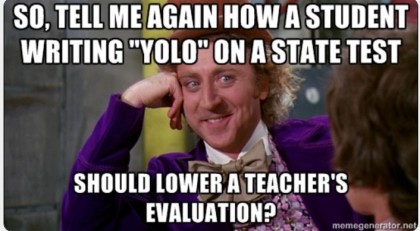Policy makers that aim to dismantle public education enjoy calling themselves “reformers.” Scott Walker likes to pretend he’s championing the common good when he takes on those teachers’ unions, which is basically the same thing as taking on ISIS. Because you see, teachers are terrorists.
One way to undermine public education is to unfairly test students and then blame the poor results on teachers. Then, have non-educators develop “value added measures” that will quantify the relative effectiveness of teachers, because teaching students is just like hitting a baseball.
Except that it’s not.
Except that scholarly journals have already debunked the validity of value added measures. Studies, like this one, have concluded the following:
They [the authors] conclude that the research base is currently insufficient to support the use of VAM for high-stakes decisions about individual teachers or schools.
Not convinced? The American Statistical Association also slammed this model for teacher evaluations.
Don’t let research stop you though. Obviously, these “reformers” aren’t going to let reason get in the way of their mission.
Charter school corporations routinely contribute campaign funds to state legislators and governors, so that they may in turn deem public schools (and union teachers) failing, and then pave the way for charter schools.
New York governor-slash-anti-teacher zealot, Andrew Cuomo (a freaking Democrat!) is off to a great start – two thirds of New York students failed the PARCC test.
Now, what makes more sense? That the PARCC test is fundamentally flawed, or that 67% of NY students are failures?
It’s nice for Pearson. They make a test that few can pass, and then they can sell remedial programs to districts and parents that will help students pass the test (that they intentionally made in such a way that nobody can pass.) Cha-ching!
Surely the citizens of the great state of NY, and of other states in the union, can see through this transparent money-grab by connected lobbyists.
How do parents stand for this?
Well, I would argue that it’s because of stories like this.
If you don’t have time to read it, it’s a wonderful piece about a talented teacher serving in a rural Oklahoma school district. It’s part of a series on NPR profiling excellent teachers. I commend NPR for doing this series, because most of the coverage about teachers I see is concerned with the teachers who have committed crimes.
Here are the highlights:
- Sarah Hagan is a 25-year-old National Merit Scholar who is teaching in Drumright, OK, in a district that pays teachers $30,000 a year.
- She is super creative and makes math fun – she doesn’t even use the textbooks!
- Sometimes she uses spaghetti in her lessons.
- She doesn’t let kids fail – to that end she stays for hours after school working (for free) to make sure they understand the concepts.
- The people in Drumright, OK can’t believe their luck.
Okay, here’s the thing. This teacher sounds a lot like many of the teachers that I currently work with. I applaud her efforts. I do.
But she’s being singled out as though her actions were out of the ordinary for teachers.
Her profile is the profile of countless teachers across the country – they work long hours for low pay, especially when considering the level of education they have.
How is that we only value her work at $30,000? Shouldn’t she be leaning in?
The other problem I have is with some of the implicit assumptions in this piece:
- Educators are martyrs who we appreciate, but not like, appreciate-appreciate. We’re not going to pay them more.
- The town of Drumright, OK hit the lottery with this teacher – she could have taught anywhere! The assumption is that rural schools or poorer, urban schools don’t deserve a teacher of her caliber. Meanwhile, those are exactly the type of districts that need the best teachers.
- Teachers should be commended for working for free.
- Teachers should be commended for having their work be all-consuming. They should not have a life outside of work.
The last two, in particular, really irk me. What other workplace values an employee’s time so little that they expect him to work for free? (I mean, other than Amazon.) And what’s the benefit of working 60 hours a week? Hedge fund managers might work those hours…but then again, they are making hundreds of thousands of dollars annually, if not millions. Should we really expect teachers to carry on with that much work for $30,000?
Sure, she might be receiving praise in this article. But what’s the rest of the discussion about teachers like? Well, the Huffington Post has a category tag called “Bad Teachers” to collect stories about the criminal ones. They do not have a tag called “Good Teachers.” Then you’ve got the Scott Walkers and Andrew Cuomos of the country using their platforms as governors to poison the public against teachers.
It’s the ultimate irony that these people corporate-education puppets are going to decide what “value” the teachers in the state add to their students when they value 60 hours of work per week at about $30,000.
Sarah Hagan is a math teacher. Let’s do some math. Let’s assume that she’s only staying after school for 2 hours a day to help students. When she goes home, she’s spending another few hours grading papers and doing lesson plans. So, let’s say she’s working ten hours a day, five days a week (this is a huge under-estimate.) Now, teachers have all that free time in the summer, so we have to subtract some time for that. I mean, sure, she’s probably taking classes for most of the summer and definitely planning the upcoming school year, but let’s just give her 8 weeks off (she does not have 8 weeks off. I promise you that.) Anyway, that’s 44 weeks of work at 50 hours a week, or 2200 hours of work for $30,000. She’s making a whopping $13.63 an hour!
Keep in mind, she’s actually making far less than that because I am going to assume that she works on weekends and does not have 8 weeks off in the summer.
We value that service so much that not only do we pay her very little, but we are actively working to take away basic employment protections like tenure. We are also jeopardizing her retirement and making her pay more and more for health care. We don’t want her to have a family, obviously. Like all teachers, she should be a spinster that eats, sleeps, and breathes teaching twenty-four hours a day.
The article does mention that people worry that she might burn out, given the demands of the occupation. Statistics are not in her favor. She will most likely move to a more affluent district or drop out of teaching entirely in the coming years.
So what value does Ms. Hagan add to her classroom? Surely we can’t just ask her students (I mean they love her, but how can we know if she’s really adding value.) And we can’t just take the word of her colleagues and principal, as they did in the article. Let’s make sure we give her students a test that is supremely unfair, a test so flawed that two-thirds are destined to fail, and that was clearly only written to benefit the bottom line of Pearson.
Then we can really assess her value.

